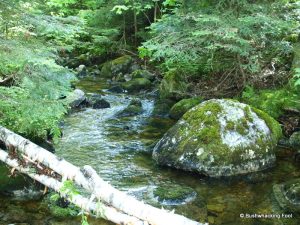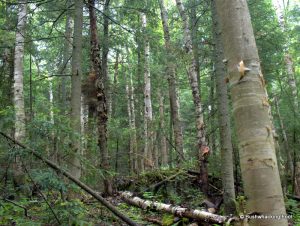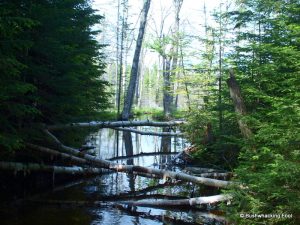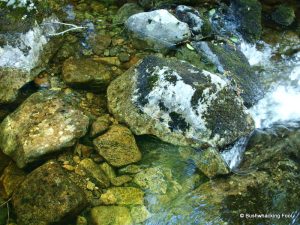
Hale Brook
It is do or die time.
After retreating off Jay Mountain the previous day due to dwindling daylight and threatening skies, I find myself back in the position of deciding whether to continue on with my trip or scrapping the whole thing altogether. The prospect of heading home, tail firmly embedded between legs, with the opportunity to explore Lot 8 gone, perhaps forever, is a bitter pill to swallow indeed.
Despite the wet conditions and the dark skies, the forecast is for nicer conditions, so I decide to accept that as truth and push on, attempting to make it to Lot 8 before the sun sets, or at least put a good dent in the distance. The time for sidetracks to search for attractive views on open cliffs along the way is over, as now I need to focus on reducing the distance between Lot 8 and myself.
Before making haste though, a few moments are made available for enjoying the views from Jay Mountain, which come sporadically as the sun occasionally peeks out from behind the clouds only to disappear again soon after. Unfortunately, too much lolly-gaging is not possible, so I pull myself together and start back down the trail toward a col a short distance back along the range.
Lot 8 remains many miles to the east, but with each step, I am a little bit closer.
Section Stats:
Date: June 18, 2014
Length: 2.0 miles (5.1 total daily miles; 10.2 total trip miles)
Difficulty: Moderate
In a short time, I reach the col, where according to my map, a gradual descent to the north, probably along a small seasonal stream, allows for avoiding any steep slopes. From there, I will gradually turn east towards Hale Brook, my original destination for the previous night.
Before stepping off the trail, I take a moment to realize this is the moment of truth, with no easy opportunity to bail out again from my route. It takes barely a moment, before my steely reserve returns, compelling me forward as I disappear into the surrounding forest, soaking wet but at least out of the windy conditions of the open range.
After descending steadily through a semi-open paper birch forest, with conifers mixed in for good measure, my 45 degree bearing leads me right to a small stream, just as I thought it might. I stop often to marvel at the stately large white trees surrounding me, their flaying bark peeling off for as far as the eye can see. The occasional spruce further accentuates the chalky white of the birches, making an attractive contrast all around me.
Eventually, the paper birches presence diminishes, as the forest gets more coniferous, while my descent transforms into climbing as I ascend a small knoll. The knoll’s forest not only becomes increasingly coniferous, but younger too, consisting almost entirely of saplings at about waist height. Below this low canopy are numerous concealed blowdowns, each a soaking wet trap just waiting to bruise, cut or puncture my legs, or worse, as I slowly struggle through them.
After a short struggle, I start looking for alternative routes. Of my options, a full-on retreat seems the most prudent, so I turn and start climbing Jay Mountain once again, though trying to go as eastward as possible while I do it. Soon, I’m out of the tangle of coniferous blowdowns and back into a more mature and spacious coniferous forest, probably much like the previous forest I ran away from before it met its untimely death at the hands of a stiff wind.
As I continue west, rocky cliffs appear downslope, making me thankful I ditched my previous bearing just when I did. From glancing at the map and watching my GPS, it seems as if there should be some rocky cliffs upslope as I continue east too, leaving threading the needle between these two cliffs as my only viable approach to avoid getting into any more precarious situations before reaching Hale Brook.

Paper birch forest
As the descent becomes steady once again, glimpses of an open area downslope occasionally pop into view. It looks like open water from my vantage point, but neither the USGS map nor the GPS show any bodies of water in this area. My perplexity largely vanishes, replaced by joy when the clouds begin breaking up and slivers of sunlight penetrate the otherwise murky forest.
As I draw closer, it becomes apparent that the clearing is indeed a wetland with a combination of open water and boggy areas. Numerous snags still stand, their bleached wood contrasting with the surrounding dark greens of the forest. Despite the elevation and lack of wetlands, I get the feeling that I am looking at the handy work of the industrious rodent, the beaver.
As I continue to descend towards the southern end of the wetland (i.e. upstream), the forest starts to transform in composition somewhat. The paper birches decrease, their cousin, the yellow birch replacing them. In addition, young sugar maples begin showing up in the understory too. The transition to a lower elevation birch-beech-maple has begun.

Wetland along Hale Brook
When I finally start seeing the telltale signs of water, denser coniferous trees, it does not take long before I can hear the rushing water of Hale Brook. Not a moment too soon either, as despite all the wet vegetation I navigated through to this point, my drinking water reserves are low and in desperate need of replenishing.
I cross the stream just a short distance up from the wetland, which appears like a bright window into another world from where I conveniently rock-hop across the flowing water. Hale Brook is a small stream here, though bigger than the few smaller ones crossed on the way down from Jay Mountain. Moss covered rocks abound in the stream, as do paper birch logs, although many too small to assist my crossing.
As I suspected, along the shore of the brook are numerous signs of recent beaver activity. Gnawed stumps lie scattered along the shore on both sides, mostly paper birches, with a few still standing works in progress. That beavers live on the side of this mountain, with such a lack of habitat, is a marvel unto itself.

Crystal clear Hale Brook
With the time approaching four in the afternoon, I get right to work setting up my gravity filter. I need to make haste, as I would like to make it as close to Lot 8 as possible before the day is done. Figuring out a new bearing while waiting for my water to work its way through the filter, I settle on 85 degrees, which should take me towards Bald Peak. A col between the peak and Seventy Mountain provides me with the ideal way to approach Lot 8.
While filtering, the sky partially clears, making me exceedingly more confident that I might just make it to Lot 8 before nightfall. With a late sunset, I should be able to keep going until about eight in the evening, giving me a whole four more hours of bushwhacking. Lucky me!
With the sun out, I shed my rain gear for the first time today, hoping that I will not need it again on this trip. Unencumbered without my rain pants catching on everything, should allow for making even better time on what I hope to be my last leg of today’s journey.
Here I come Lot 8, ready or not.
Affiliate Disclaimer: Some links within this blog post may send you to a retailer’s website. If you chose to purchase any product on that site, this author may receive a small commission at no extra cost you. These commissions provide compensation for the author’s time and effort necessary to provide the content at the Bushwhacking Fool.



